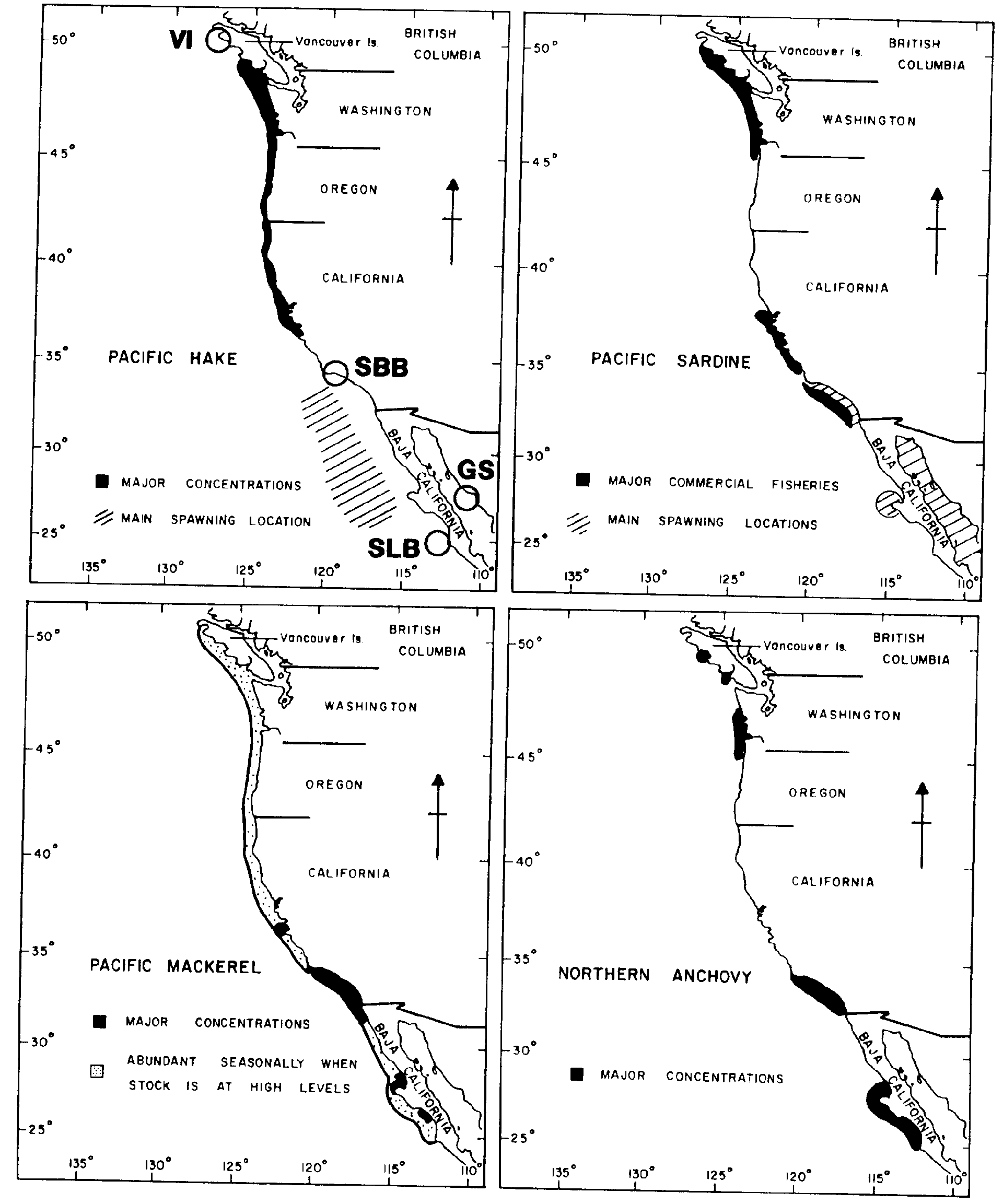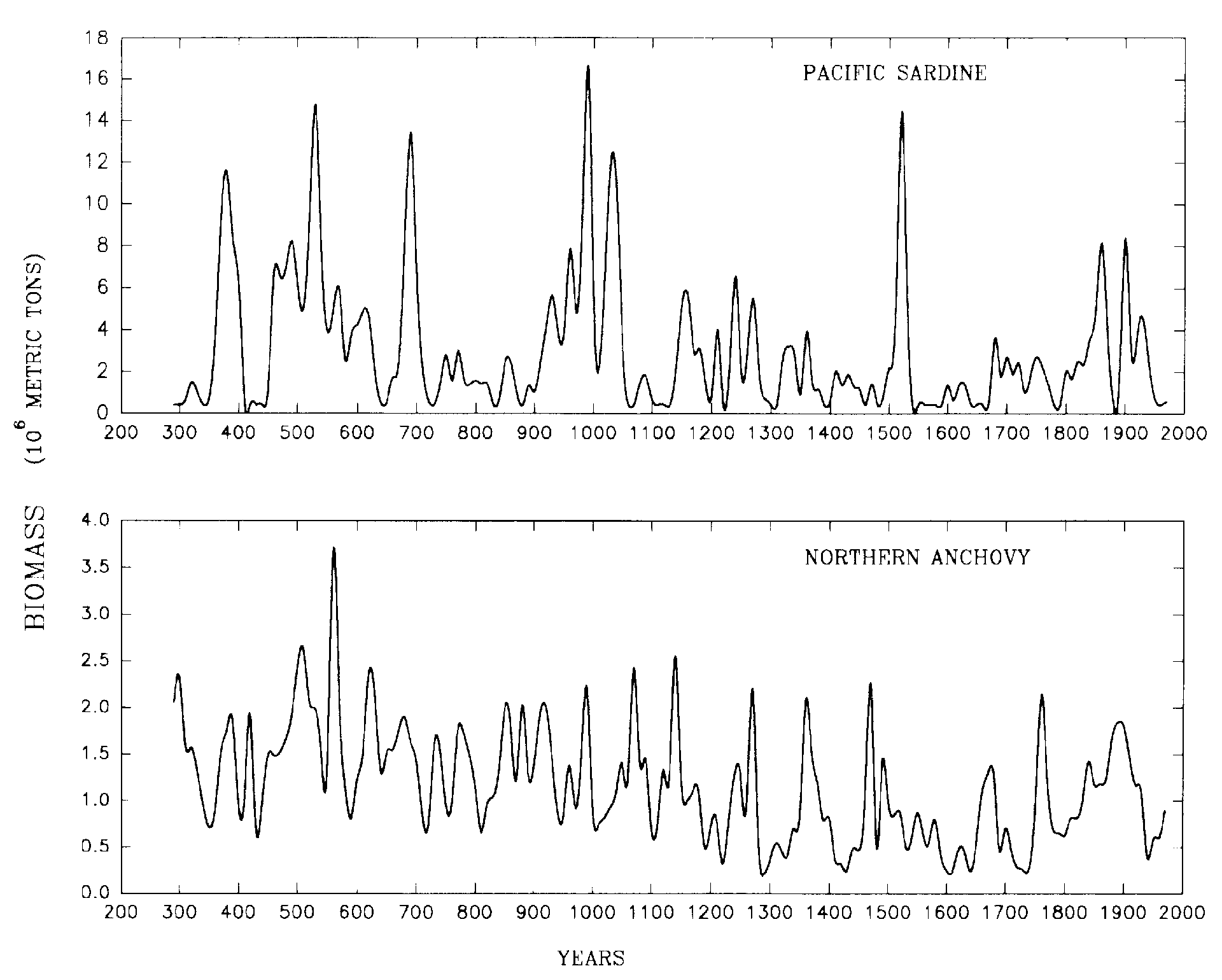WORKING GROUP REPORTS
Paleo-oceanographic and Long-Term Historic Evidence of Past Variability
Cochairs: T. Baumgartner and L. Sautter
Participants: D. Ainley, M. Eakin, D. Hedgecock, A. Hollowed, M. Mullin, G. Rau, J. Rice, P.
Smith, and L. Welling
Two major challenges that face GLOBEC are detecting ecosystem
response to global change, and disentangling the effects of
anthropogenic forcing from those induced by natural variability in
the climate system. Knowledge of the past is vital to the design and
implementation of programs to meet these challenges. Two exceptional
and complementary sets of historical information - the
high-resolution paleosedimentary record and the CalCOFI data set -
offer a compelling argument for a California Current/eastern boundary
GLOBEC initiative.
Several sites in the California Current contain anaerobic "sediment
memories" of ecological variability over unusually short time scales
of decadal, yearly, and even seasonal periods. Two confirmed sites
and one potential site exist in the California Current system, plus
an additional site in the Gulf of California, Mexico (Fig. 8).
Information from these anaerobic sites has been used, for example, to
reconstruct the biomass of northern anchovy and sardine populations
over the last 2000 years, based on the abundance of their scales in
the sediments of the Santa Barbara Basin (Fig. 9; Soutar and Isaacs
1974; Baumgartner et al. 1992). A variety of ecologic and geochemical
information can also be extracted from sedimentary plankton remains
to characterize the history of variability in the physical and
biological environment in which the fish were living.
The CalCOFI data set documents the California Current ecosystem over
the last four decades and offers a unique and ongoing opportunity to
quantify the dynamics of populations and communities over interannual
and decadal time scales. Integration of the paleoecological series
and the historical CalCOFI data will be a powerful tool in the
development of GLOBEC modeling and field sampling programs. Use of
the CalCOFI information to interpret the high-resolution
paleo-oceanographic record also helps us not just to describe, but
also to understand the history of the California Current over the
past century and back through at least two millennia. Conversely,
modeling of ecosystem responses, based on present-day data, can be
validated against the changes documented from the CalCOFI and the
paleoecological data.

Figure 8. Circles in the upper left box indicate the known and
potential sites for reconstructing the histories of coastal pelagic
fish populations from anaerobic depositional environments. These are
the fjords on the Pacific coast of Vancouver Island (VI; still
untested for fish scales), the Santa Barbara Basin (SBB), the Soledad
Basin (SLB), and the Guaymas Slope (GS) in the Gulf of California.
The four charts indicate the principal areas of concentration and
spawning of the four dominant coastal pelagic species during summer,
according to the sources used by Ware and McFarlane (1989) for this
compilation.

Figure 9. 1650-year proxy time series of biomass estimates for
Pacific sardine and northern anchovy off California, based on the
relationship between scale-deposition rates and modern population
estimates (Baumgartner et al. 1992).
KEY RESEARCH PROBLEMS AND APPROACHES
The working group began its session with informal presentations by several members. These
emphasized the importance of key research questions or issues and led to a discussion on possible
study sites, target species, and appropriate tools. By the end of the session, members had agreed that
to understand how populations change on climatic time scales, we need to:
- Determine the characteristic time scales and rates of change in the California Current ecosystem that
are associated with global climate change. This requires extensive and detailed analysis of accurately
dated, high-resolution sediment records.
- Calibrate paleo-oceanographic records of population dynamics and environmental change against
sediment-trap records to monitor present-day patterns in particle fluxes. This is necessary to determine
the ways in which population change is transmitted to and preserved in the sediments. Sediment-trap
studies offer a unique perspective on the ecology of fish and plankton species and lay the groundwork
for reconstructing environmental settings. These studies will allow us to select appropriate plankton
taxa as proxies for specific hydrographic conditions (e.g., Sautter and Thunell 1991) and will greatly
amplify the value of fossil plankton (foraminifera, radiolaria, and diatoms) and fish remains as records
of population shifts that reflect changing environmental conditions.
- Use historical data bases and sample archives from CalCOFI to document changes in populations
and communities and their relationships to global climate changes. The Scripps Institution of
Oceanography, the Southwest Fisheries Science Center of NOAA/NMFS, and the California
Department of Fish and Game have archives of fish and plankton samples as well as ancillary
hydrographic and biological data from the late 1930s to the present, with continuous surveys of key
areas since 1951.
- Extrapolate the basin-specific paleoenvironmental records from the Southern California Bight to
population and environmental changes over a wider geographic region of the CCS using contemporary
sediment-trap studies. Sediment-trap data can test the generality of the Santa Barbara Basin fish-scale
record with respect to the larger habitat of the fish and can relate scale-deposition rates to current
biomass estimates of target species.
- Explore promising sites for high-resolution paleo-oceanographic records outside the Southern
California Bight along the west coast of North America (Fig. 8). The silled fjords in British Columbia
have not yet been adequately searched for preserved fish scales. The existence of a fish-scale record in
Soledad Basin off southern Baja California has been documented (Soutar and Isaacs 1974) but not
well developed. Exploration and development of the information from these sites will yield a fuller
description of spatial variability in conjunction with the long-term records.
- Integrate sediment-trap-based flux studies into a long-term monitoring program to collect
continuous seasonal, interannual, and decadal information about the ecosystem. This program would
be part of the long-term GLOBEC monitoring study outlined in section 3.7 of this report. Such
monitoring of selected sites and variables should be continued at least 20 years after the intensive
studies of GLOBEC are concluded, to make sure that contemporaneous ecosystem change is detected.
- Use paleo-oceanographic and historical data sets to constrain and test oceanographic and population
models. Past changes in fish abundances from the sedimentary record can be used to constrain
contemporary models of climatic effects on fish population dynamics. The quality of the information
now emerging will be improved by finer sampling intervals in the long record. We envision a detailed
study (e.g., two-year sample intervals) comparing contemporary twentieth-century warming with the
medieval warming event that occurred between A.D. 900 and 1300.
TOOLS AND METHODOLOGIES
Documentation and Interpretation of the High-Resolution Sedimentary Record
The components available for study from the sediments are preserved hard parts of animals (e.g., fish
scales, foram shells, and radiolarian skeletons) and phytoplankton (mostly diatom valves); bulk
measurements of organic carbon and nitrogen, and of carbonate and silica; and the inorganic and
organic elemental, isotopic, and molecular constituents of the fossil material (e.g. ,trace metals, stable
light isotopes, lipid biomarkers, and genetic material). Ambient concentrations of some trace metals
(barium, cadmium) and stable isotopes (180 and 13C) are preserved in the shells of planktonic
foraminifera, providing information about changes in the upper water column's chemical and physical
properties. Fish scales preserved in the anaerobic sediments allow us to study the variability of the
pelagic species important to GLOBEC, such as hake, sardines, and anchovies.
Analysis of Data Archives from Historical Collections
The 40 years of CalCOFI data and samples represent a rare opportunity to document variation in
zooplankton populations and community structure and to link these with known changes in climate and
ocean circulation. It is also possible to use plankton species archived by CalCOFI to investigate the
variation in carbon and nitrogen dynamics in the CCS by measuring changes in stable isotope
abundances, and to examine genetic variation by sequencing DNA in formalin-preserved specimens.
Historic variations of 13C/l2C and 15N/14N ratios within low-trophic-level zooplankton biomass will
point to changes in carbon and nitrogen biogeochemistry within the CCS. Isotopic variation within
these samples will help researchers interpret isotopic signals of the much-longer-term sedimentary
record.
Finally, the relationship between scale-deposition rates from the Santa Barbara Basin sediments and
the biomass of pelagic fish populations is still not well determined. There is only a brief overlap (eight
data points using 5-year averages in Soutar and Isaacs 1974) between the existing sedimentary data
and the fish population estimates (1932-69). We now have better population estimates and evidence of
significant population changes for the period since 1970. Therefore, we can significantly improve
calibration of scale-deposition rates by updating the sedimentary record and its relationship to the
improved biomass estimates.
Calibration of the Sedimentary Record Through Sediment Trap Studies
Moored sediment traps are necessary in order to understand the transformation processes of material
descending to the seafloor. Such traps also make it possible to the calibrate the sedimentary record to
the overlying waters. Automated time-series traps and single-cup collectors should be used together.
The spatial variability in deposition rates of pelagic fish scales should be assessed by multiple
moorings of single-cup collectors. High-resolution time series of weekly, or at most biweekly,
collections are needed to link particulate flux to hydrographic and biotic changes in the California
Current. The sediment trap results will provide a continuous series of "snapshots" of the plankton
between the quarterly CalCOFI cruises.
These studies would be enhanced if done in conjunction with the intensive field studies of the
GLOBEC program. If the intensive field studies were augmented with sediment-trap information, we
could observe how planktonic responses to ocean physics and associated biological productivity are
preserved in the sedimentary record . We also could determine if fossil plankton taxa could be used as
proxies for other plankton (especially fish larvae) not preserved in the sedimentary record.

